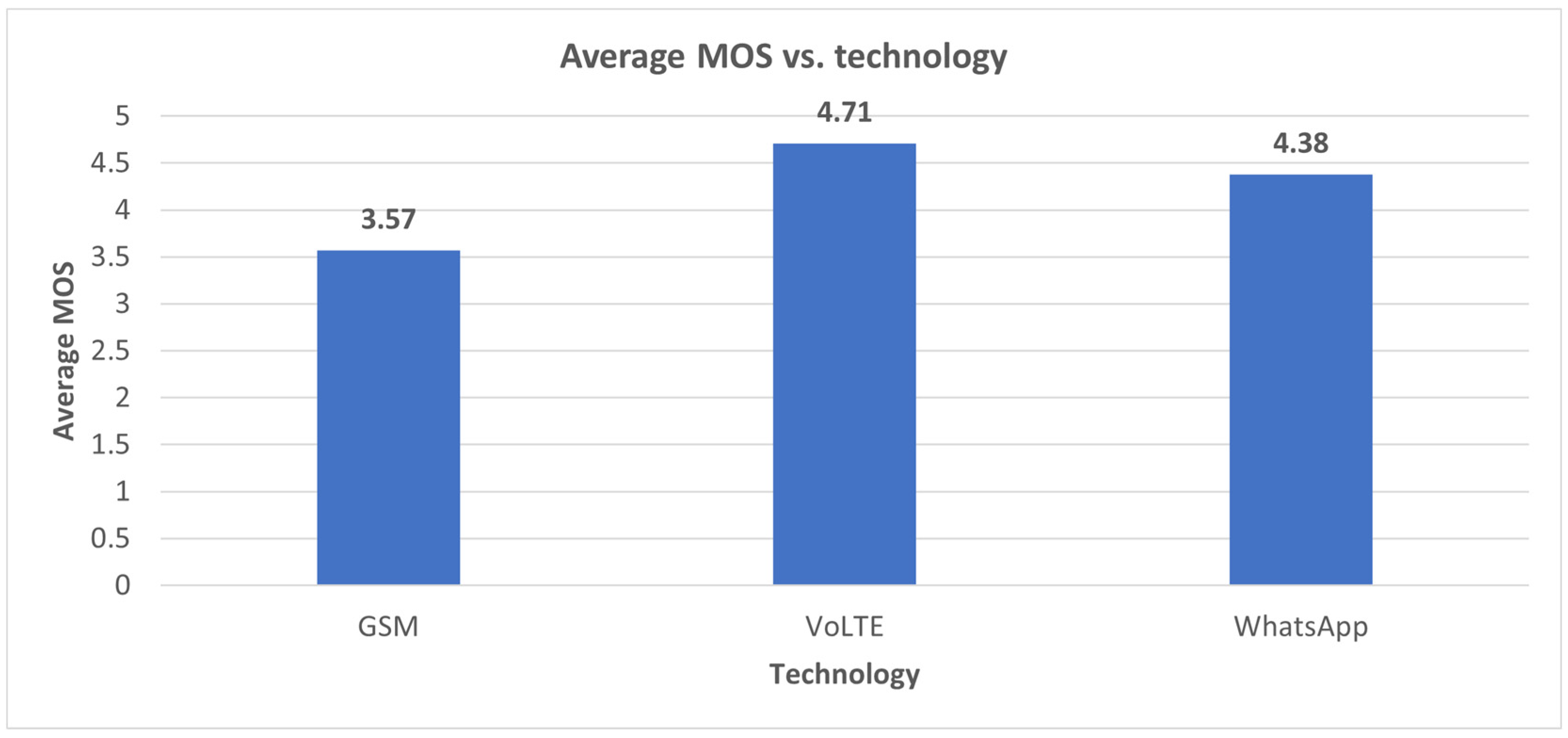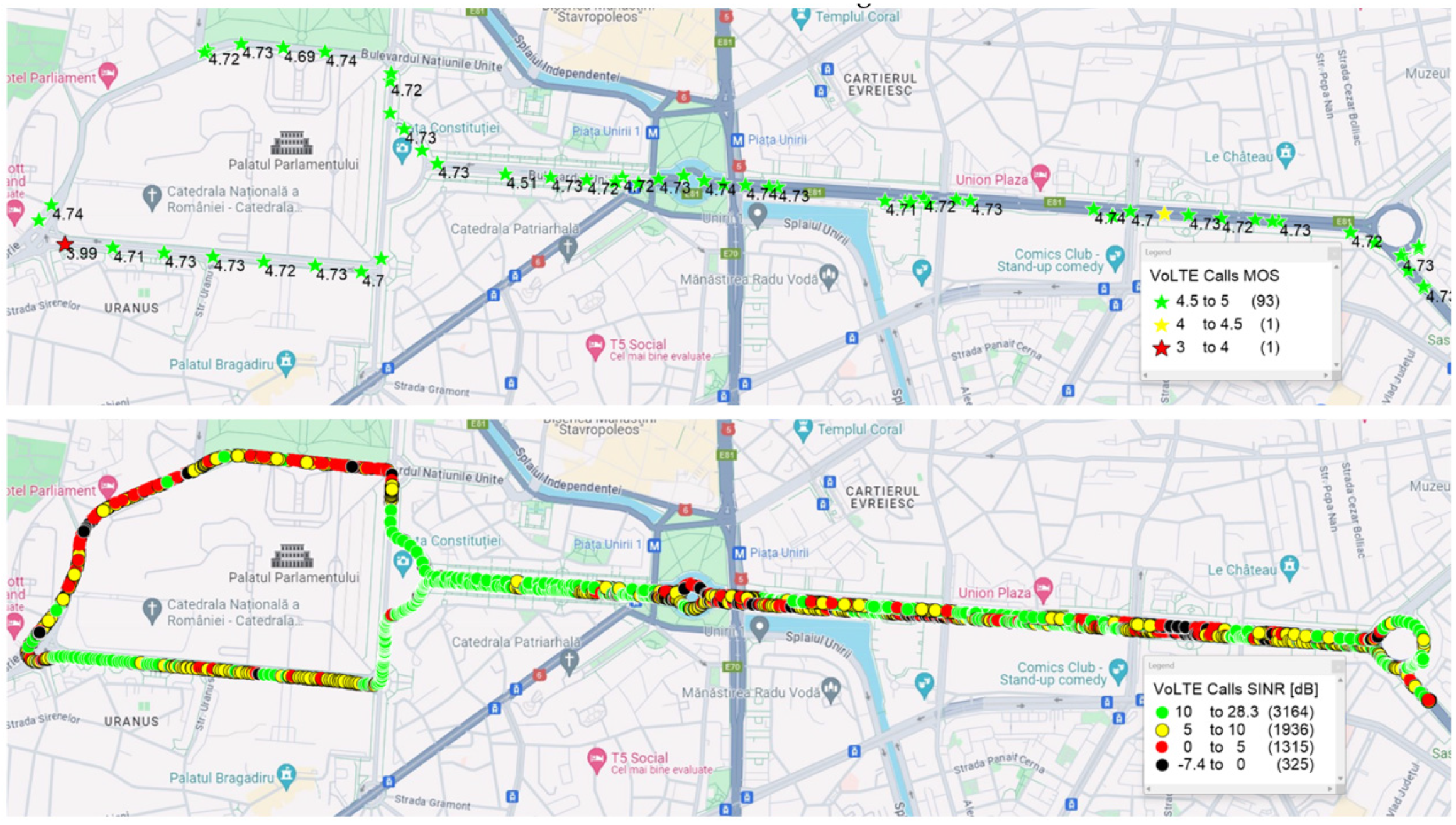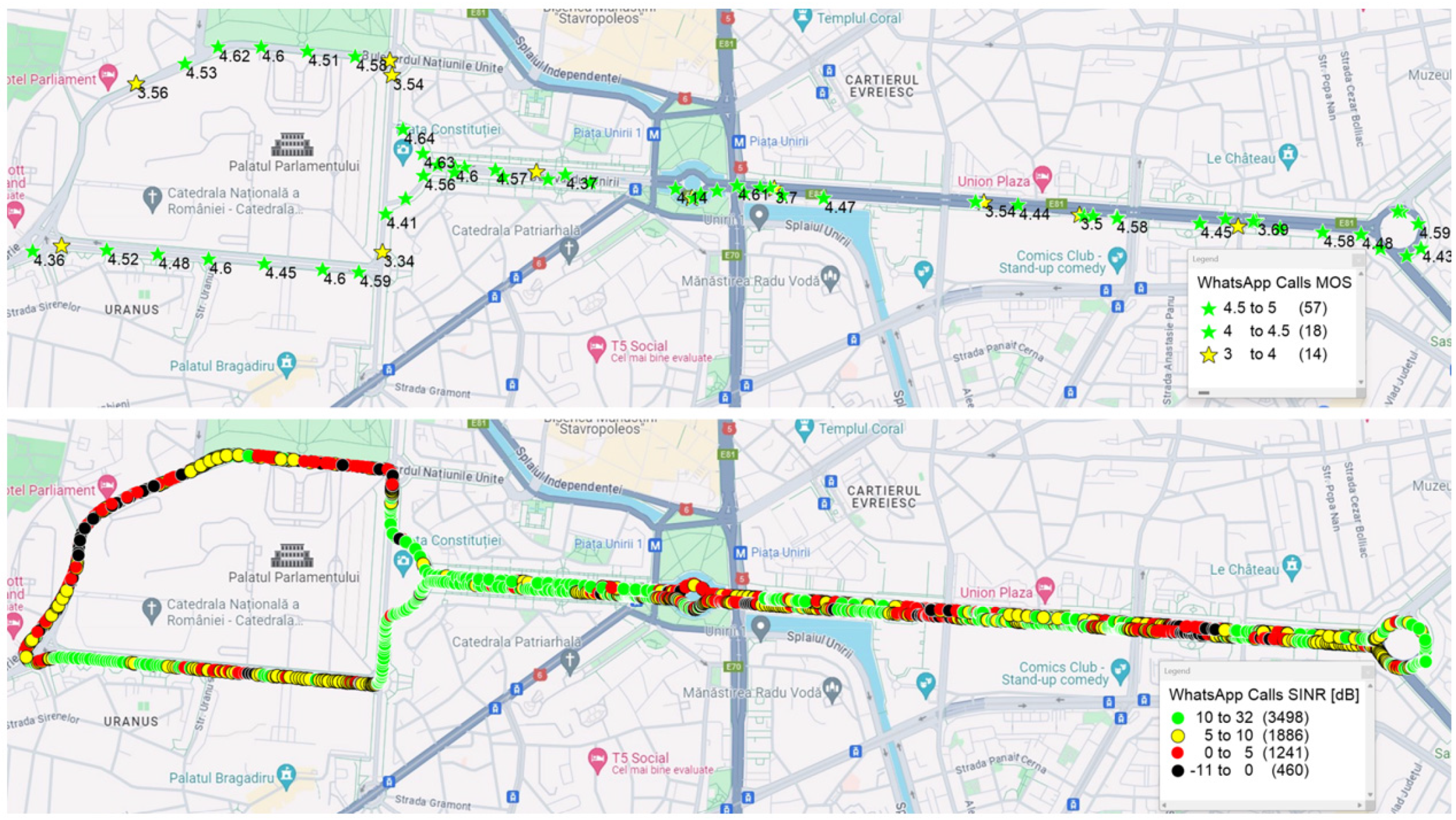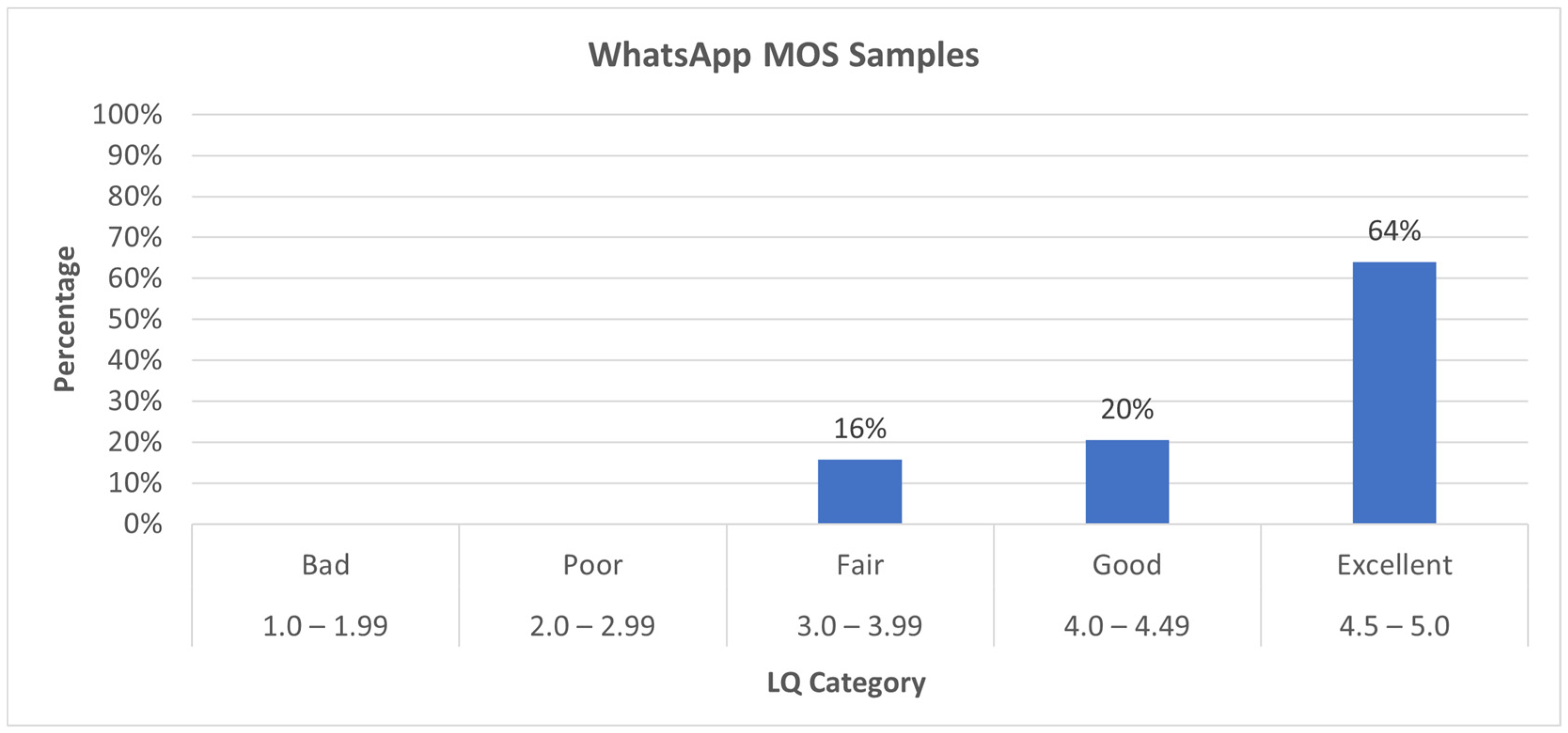Voice Quality Evaluation in a Mobile Cellular Network: In Situ Mean Opinion Score Measurements
Abstract
1. Introduction
2. The State of the Art
Key Strengths of Our Work
3. Speech Quality Measurements with POLQA ITU-T P.863
Transmision Path and Modeling in POLQA ITU-T P.863
4. MOS Parameters in Voice Quality Evaluation
5. Experimental Setup
5.1. QualiPoc Test Application
5.2. Drive Test Route and Scenarios
6. Drive Test Results and Performance Evaluation
6.1. MOS Evaluation
6.2. Performance Evaluation
7. Conclusions
Author Contributions
Funding
Informed Consent Statement
Data Availability Statement
Acknowledgments
Conflicts of Interest
References
- Vaser, M.; Maggiore, G. Improved VoLTE QoE Estimation Procedure using Network Performance Metrics. In Proceedings of the Eleventh International Conference on Ubiquitous and Future Networks (ICUFN), Zagreb, Croatia, 2–5 July 2019; pp. 361–365. [Google Scholar] [CrossRef]
- The Next-Generation Mobile Voice Quality Testing Standard. Available online: http://www.polqa.info/ (accessed on 15 June 2024).
- ITU-T Rec. P.863; Perceptual Objective Listening Quality Assessment (POLQA). International Telecommunication Union-Telecommunication Standardization Sector: Geneva, Switzerland, 2011.
- Arifianto, D.; Sulistomo, T.R. Subjective evaluation of voice quality over GSM network for quality of experience (QoE) measurement. In Proceedings of the International Symposium on Intelligent Signal Processing and Communication Systems (ISPACS), Nusa Dua Bali, Indonesia, 9–12 November 2015; pp. 148–152. [Google Scholar] [CrossRef]
- Roslin, R.J.B.; Khalifa, O.O.; Bhuiyan, S.S.N. Improved Voice Over Internet Protocol for Wireless Devices. In Proceedings of the 7th International Conference on Computer and Communication Engineering (ICCCE), Kuala Lumpur, Malaysia, 19–20 September 2018; pp. 498–503. [Google Scholar] [CrossRef]
- European 5G Observatory. Available online: https://5gobservatory.eu/ (accessed on 15 June 2024).
- Villaluz, M.D.; Wicaksono, R.P.; Dan Ebora Atienza, A.; Kunishige, S.; Chang, K.; Caasi, J.B. VoLTE SRVCC optimization as interim solution for LTE networks with coverage discontinuity. In Proceedings of the International Conference on Information and Communication Technology Convergence (ICTC), Jeju, Republic of Korea, 28–30 October 2015; pp. 212–216. [Google Scholar] [CrossRef]
- 2G/3G Network Shutdown Status and Challenges. Available online: https://www.smartviser.com/post/2g-3gnetworkshutdown (accessed on 15 June 2024).
- Chabi, A.F.; de Aguiar, M.F.; Carvalho, J.K.; de Aquino Rodrigues, V.; Campos, J.V.; Fonseca, B.; De Sousa, J.O. Voice Quality Experience Evaluation: MOS Laboratory Test and Spectrum Analysis of Failures in VoLTE Calls. In Proceedings of the IEEE International Conference on Industry 4.0, Artificial Intelligence, and Communications Technology (IAICT), Bali, Indonesia, 13–15 July 2023; pp. 201–207. [Google Scholar] [CrossRef]
- Souček, P.; Holub, J. Evaluation of ITU-T P.863 POLQA in Chinese environment. In Proceedings of the IEEE 1st International Symposium on Wireless Systems (IDAACS-SWS), Offenburg, Germany, 20–21 September 2012; pp. 124–126. [Google Scholar] [CrossRef]
- ITU-T Rec. P.862; Perceptual Evaluation of Speech Quality (PESQ), An Objective Method for End-to-end Speech Quality Assessment of Narrowband Telephone Networks and Speech Codecs. International Telecommunication Union-Telecommunication Standardization Sector: Geneva, Switzerland, 2001.
- Patel, N.; Patel, S.; Tan, W.L. Performance Comparison of WhatsApp versus Skype on Smart Phones. In Proceedings of the 28th International Telecommunication Networks and Applications Conference (ITNAC), Sydney, NSW, Australia, 21–23 November 2018; pp. 1–3. [Google Scholar] [CrossRef][Green Version]
- Sharma, D.; Hogg, A.O.T.; Wang, Y.; Nour-Eldin, A.; Naylor, P.A. Non-Intrusive POLQA Estimation of Speech Quality using Recurrent Neural Networks. In Proceedings of the 27th European Signal Processing Conference (EUSIPCO), A Coruna, Spain, 2–6 September 2019; pp. 1–5. [Google Scholar] [CrossRef]
- Ouyang, Y.; Yan, T.; Wang, G. CrowdMi. Scalable and Diagnosable Mobile Voice Quality Assessment Through Wireless Analytics. IEEE Internet Things J. 2015, 2, 287–294. [Google Scholar] [CrossRef]
- Orosz, P.; Tóthfalusi, T. VoicePerf. A Quality Estimation Approach for No-reference IP Voice Traffic. In Proceedings of the NOMS 2020—2020 IEEE/IFIP Network Operations and Management Symposium, Budapest, Hungary, 20–24 April 2020; pp. 1–9. [Google Scholar] [CrossRef]
- Gutierrez, R.; Asca, B.; Kemper, G. A Computational Algorithm Based on Convolutional Neural Networks Aimed at Estimating the MOS Quality Parameter According to the Norm UIT-T P.862. In Proceedings of the XXII Symposium on Image, Signal Processing and Artificial Vision (STSIVA), Bucaramanga, Colombia, 24–26 April 2019; pp. 1–4. [Google Scholar] [CrossRef]
- Daengsi, T.; Sirawongphatsara, P.; Wuttidittachotti, P. Proposed QoE Models Associated with Delay and Jitter Using Subjective Approach and Applications for 4G and 5G Networks. In Proceedings of the 4th International Conference on Advanced Communication Technologies and Networking (CommNet), Rabat, Morocco, 3–5 December 2021; pp. 1–4. [Google Scholar] [CrossRef]
- Di, Z.; Xiao, T.; Li, Y.; Cheng, X.; Li, B.; Xu, L.; Zhu, X.; Zhi, L.; Xia, R. Research on Voice Quality Evaluation Method Based on Artificial Neural Network. In Proceedings of the IEEE International Conference on Trust, Security and Privacy in Computing and Communications (TrustCom), Wuhan, China, 9–11 December 2022; pp. 1510–1515. [Google Scholar] [CrossRef]
- Huang, T.; Liang, J.; Xiao, T. Research on 5G Coverage Capability Assessment Based on Voice Quality Intelligent Evaluation. In Proceedings of the IEEE 8th International Conference on Computer and Communications (ICCC), Chengdu, China, 9–12 December 2022; pp. 297–303. [Google Scholar] [CrossRef]
- Hines, A.; Skoglund, J.; Kokaram, A.; Harte, N. Robustness of speech quality metrics to background noise and network degradations: Comparing ViSQOL, PESQ and POLQA. In Proceedings of the 2013 IEEE International Conference on Acoustics, Speech and Signal Processing, Vancouver, BC, Canada, 26–31 May 2013; pp. 3697–3701. [Google Scholar] [CrossRef][Green Version]
- Elnashar, A.; El-saidny, M.A. Comprehensive Performance Evaluation of VoLTE. Published in Practical Guide to LTE-A, VoLTE and IoT: Paving the Way towards 5G; Wiley: Hoboken, NJ, USA, 2018; pp. 197–229. [Google Scholar] [CrossRef]
- Alhammadi, A.; El-Saleh, A.; Shayea, I. MOS Prediction for Mobile Broadband Networks Using Bayesian Artificial Intelligence. In Proceedings of the 2021 International Conference on Artificial Intelligence and Computer Science Technology (ICAICST), Yogyakarta, Indonesia, 29–30 June 2021; pp. 47–50. [Google Scholar] [CrossRef]
- Mandalari, A.M. Measuring Roaming in Europe: Infrastructure and Implications on Users’ QoE. IEEE Trans. Mob. Comput. 2022, 21, 3687–3699. [Google Scholar] [CrossRef]
- Elagin, V.S.; Belozertsev, I.A.; Goldshtein, B.S.; Onufrienko, A.V.; Vladyko, A.G. Models of QOE ensuring for OTT services. In Proceedings of the Systems of Signals Generating and Processing in the Field of on-Board Communications, Moscow, Russia, 20–21 March 2019; pp. 1–4. [Google Scholar] [CrossRef]
- Introduction to POLQA v3, Implementing the 3rd Edition of ITU-T Rec. P.863. Technical White Paper. Published by the POLQA Coalition: OPTICOM GmbH, Erlangen, Germany; Rohde & Schwarz SwissQual AG: Solothurn, Switzerland; TNO Telecom: Delft, The Netherlands. 2018; Available online: https://scdn.rohde-schwarz.com/ur/pws/dl_downloads/dl_common_library/dl_brochures_and_datasheets/pdf_1/Technical_White_Paper_POLQA_2020.pdf (accessed on 15 June 2024).
- ELAdawi, M. VoLTE RAN Features (Advanced TTI Bundling & RoHC Features)-Session 5. Available online: https://www.mohamedeladawi.com/e2e-volte-training-advanced-tti-bundling-RoHC-features-session-5/ (accessed on 15 June 2024).









| MOS Values | Quality Category |
|---|---|
| 1.0–1.99 | Bad |
| 2.0–2.99 | Poor |
| 3.0–3.99 | Fair |
| 4.0–4.49 | Good |
| 4.5–5.0 | Excellent |
| Parameter | Value [s] |
|---|---|
| Window duration | 130 |
| Call duration | 80 |
| Pause duration | 20 |
| 1st call setup delay | 5 |
| Guard time | 5 |
| Max call setup time | 30 |
| Call alerting timeout | 0 |
| Call answer timeout | 0 |
| Call pickup delay | 3.0 |
| No call setup time | 115 |
| Max failed calls | 2 |
| Pause after failed call | 30 |
| No connection timeout | 600 |
| Call Scenario | No. Samples Bad | No. Samples Poor | No. Samples Fair | No. Samples Good | No. Samples Excellent |
|---|---|---|---|---|---|
| GSM | 3 | 17 | 15 | 51 | |
| VoLTE | 1 | 1 | 93 | ||
| 14 | 18 | 57 |
| Quality Category | Degradation Cause | |||||
|---|---|---|---|---|---|---|
| Background Noise | Frame/Packet Loss | Interruptions | Variable Delay | Not to Specify | OK | |
| Poor | 1 | 13 | 1 | 2 | ||
| Bad | 1 | 2 | ||||
| Fair | 1 | 1 | 4 | 9 | ||
| Good | 51 | |||||
| Quality Category | Degradation Cause | ||
|---|---|---|---|
| Frame/Packet Loss | Variable Delay | OK | |
| Fair | 9 | 3 | 2 |
| Good | 17 | ||
| Excellent | 57 |
Disclaimer/Publisher’s Note: The statements, opinions and data contained in all publications are solely those of the individual author(s) and contributor(s) and not of MDPI and/or the editor(s). MDPI and/or the editor(s) disclaim responsibility for any injury to people or property resulting from any ideas, methods, instructions or products referred to in the content. |
© 2024 by the authors. Licensee MDPI, Basel, Switzerland. This article is an open access article distributed under the terms and conditions of the Creative Commons Attribution (CC BY) license (https://creativecommons.org/licenses/by/4.0/).
Share and Cite
Leonte, S.; Pastrav, A.; Zamfirescu, C.; Puschita, E. Voice Quality Evaluation in a Mobile Cellular Network: In Situ Mean Opinion Score Measurements. Sensors 2024, 24, 6630. https://doi.org/10.3390/s24206630
Leonte S, Pastrav A, Zamfirescu C, Puschita E. Voice Quality Evaluation in a Mobile Cellular Network: In Situ Mean Opinion Score Measurements. Sensors. 2024; 24(20):6630. https://doi.org/10.3390/s24206630
Chicago/Turabian StyleLeonte, Sorin, Andra Pastrav, Ciprian Zamfirescu, and Emanuel Puschita. 2024. "Voice Quality Evaluation in a Mobile Cellular Network: In Situ Mean Opinion Score Measurements" Sensors 24, no. 20: 6630. https://doi.org/10.3390/s24206630
APA StyleLeonte, S., Pastrav, A., Zamfirescu, C., & Puschita, E. (2024). Voice Quality Evaluation in a Mobile Cellular Network: In Situ Mean Opinion Score Measurements. Sensors, 24(20), 6630. https://doi.org/10.3390/s24206630







